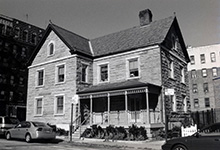Quick, what are the first and last names of the three officers acquitted in the killing of Sean Bell? I’ll give you a few seconds…
Give up? The answer is: Marc Cooper, Gescard F. Isnora, and Michael Oliver. Now, given that Sean Bell was murdered nearly 18 months ago, and that the court case and acquittal of his killers has been a prominent news story for two months, why didn’t you remember these names? Because, whether in the major media or in the courtroom, it was never the three officers who were on trial. It was Sean Bell and his friends.
Before and after the verdict, the legal proceedings at hand were dubbed: “The Sean Bell trial.” This is strange terminology, considering that Bell is the victim. (How many articles have you read about the “Ronald Goldman trial?”)
This language betrays the very reasons that Cooper, Isnora, and Oliver walked out of a Queens courtroom and into the long tradition of officers who have killed unarmed men of color with impunity. When, in November of 2006, news first broke of a 23-year-old black man gunned down on his wedding night by officers who fired 50 shots, it was so clearly heinous that those who are at once rational, empathetic, and unfamiliar with the American legal system could be forgiven for wondering: How are the officers possibly going to get themselves out of this one?
The answer, of course, is that from those initial days after Bell’s murder right up until the recent verdict, the terms of discourse in media and law were deliberately shifted, from discussing how and why yet another unarmed man of color was killed by the police to speculating about what Bell and his friends might have done to cause the officers to find them threatening. Suddenly, the central questions in the newspapers and in the courtroom became: Were Bell and his friends drinking? Did Joseph Guzman and Trent Benefield have previous arrest records? Did the officers fear for their lives? Was Guzman impatient with defense attorneys on the witness stand?
Somehow, this is what always happens when it comes to instances of black men murdered or brutalized at the hands of the police. Leading up to the 2000 acquittal of the officers who fired 41 deadly shots at Amadou Diallo, the focal point became whether it was reasonable for officers to mistake Diallo’s wallet for a gun, rather than the massacre of an innocent man.
And in many instances, police shooting cases never even make it to trial. In 1994, Nicholas Heyward Jr.—a 13-year-old boy—was playing with a plastic toy gun in his housing complex in Brooklyn, when a housing officer shot and killed him.
In 2000, Patrick Dorismond—26 years old and unarmed—was walking near Madison Square Garden when undercover officers tried to sell him marijuana. Before long, officers had shot and killed him too.
In 2004, Timothy Stansbury Jr.—19-years-old and unarmed—was walking across a rooftop on his way home when a housing officer gunned him down.
None of the officers in these cases ever faced a criminal trial.
So why do police officers continue to literally get away with murder? A big part of the answer is because white America lets them.
Historically speaking, a major factor in the lack of massive, society-wide outrage over police shootings of unarmed black men is the fact that, as long as it isn’t their own sons, brothers, or fathers who are being gunned down, far too many white Americans are willing to convince themselves that victims of police shootings must have done something to invite their fates.
As a 26-year-old white male, I submit that the murder of Sean Bell is not just a “black issue.” It is a human issue. And it is past time for white Americans to wake up, and to stop operating on the assumption—at once immoral and erroneous—that if they do not speak out against injustice, they will remain safe from it.
In recent days, I have interviewed many Highbridge residents—particularly young black men—who are afraid that what happened to Sean Bell could soon happen to them.
I, in turn, fear their words could be prophetic. Unless people of conscience, and of all races, come together to denounce the profound injustice of Sean Bell’s murder.
No more.
Tony Richards is the editor of the Highbridge Horizon, a community newspaper in the Highbridge section of the Bronx. He can be reached at richardst@highbridgelife.org




